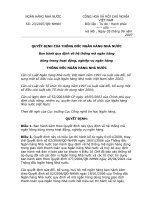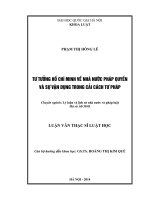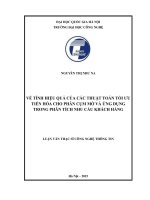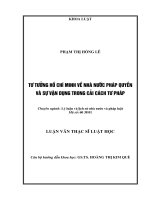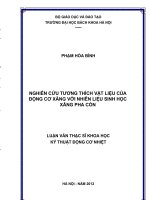Tiêu chuẩn ASTM về quy cách của Ethyl Tertiary-Butyl Ether (ETBE) dùng trong phối trộn với nhiên liệu hàng không
Bạn đang xem bản rút gọn của tài liệu. Xem và tải ngay bản đầy đủ của tài liệu tại đây (85.38 KB, 4 trang )
This international standard was developed in accordance with internationally recognized principles on standardization established in the Decision on Principles for the
Development of International Standards, Guides and Recommendations issued by the World Trade Organization Technical Barriers to Trade (TBT) Committee.
Designation: D7618 − 13 (Reapproved 2017)
An American National Standard
Standard Specification for
Ethyl Tertiary-Butyl Ether (ETBE) for Blending with Aviation
Spark-Ignition Engine Fuel1
This standard is issued under the fixed designation D7618; the number immediately following the designation indicates the year of
original adoption or, in the case of revision, the year of last revision. A number in parentheses indicates the year of last reapproval. A
superscript epsilon (´) indicates an editorial change since the last revision or reapproval.
1. Scope
1.1 This specification covers requirements for fuel grade
ethyl tertiary-butyl ether (ETBE) that may be used for blending
with fuels for aviation spark-ignition engines where permissible. Other ETBE grades available in the marketplace that do
not comply with the requirements of this specification, are not
suitable for blending with aviation fuels.
1.2 The values stated in SI units are to be regarded as
standard. No other units of measurement are included in this
standard.
1.3 This standard does not purport to address all of the
safety concerns, if any, associated with its use. It is the
responsibility of the user of this standard to establish appropriate safety and health practices and determine the applicability of regulatory limitations prior to use.
1.4 This international standard was developed in accordance with internationally recognized principles on standardization established in the Decision on Principles for the
Development of International Standards, Guides and Recommendations issued by the World Trade Organization Technical
Barriers to Trade (TBT) Committee.
2. Referenced Documents
2.1 ASTM Standards:2
D130 Test Method for Corrosiveness to Copper from Petroleum Products by Copper Strip Test
D156 Test Method for Saybolt Color of Petroleum Products
(Saybolt Chromometer Method)
D381 Test Method for Gum Content in Fuels by Jet Evaporation
D1298 Test Method for Density, Relative Density, or API
Gravity of Crude Petroleum and Liquid Petroleum Prod1
This specification is under the jurisdiction of ASTM Committee D02 on
Petroleum Products, Liquid Fuels, and Lubricants and is the direct responsibility of
Subcommittee D02.J0.04 on Additives and Electrical Properties.
Current edition approved June 1, 2017. Published July 2017. Originally approved
in 2010. Last previous edition approved in 2013 as D7618 – 13. DOI: 10.1520/
D7618-13R17.
2
For referenced ASTM standards, visit the ASTM website, www.astm.org, or
contact ASTM Customer Service at For Annual Book of ASTM
Standards volume information, refer to the standard’s Document Summary page on
the ASTM website.
ucts by Hydrometer Method
D4052 Test Method for Density, Relative Density, and API
Gravity of Liquids by Digital Density Meter
D4057 Practice for Manual Sampling of Petroleum and
Petroleum Products
D4171 Specification for Fuel System Icing Inhibitors
D4176 Test Method for Free Water and Particulate Contamination in Distillate Fuels (Visual Inspection Procedures)
D4177 Practice for Automatic Sampling of Petroleum and
Petroleum Products
D5854 Practice for Mixing and Handling of Liquid Samples
of Petroleum and Petroleum Products
D7796 Test Method for Analysis of Ethyl tert-Butyl Ether
(ETBE) by Gas Chromatography
E203 Test Method for Water Using Volumetric Karl Fischer
Titration
E300 Practice for Sampling Industrial Chemicals
E1064 Test Method for Water in Organic Liquids by Coulometric Karl Fischer Titration
3. Terminology
3.1 Definitions:
3.1.1 ethanol, n—chemical compound C2H5OH.
3.1.2 methanol, n—chemical compound CH3OH.
3.1.3 ethyl tertiary-butyl ether (ETBE), n—chemical compound CH3CH2OC(CH3)3.
3.1.4 tertiary-butyl alcohol (TBA), n—chemical compound
(CH3)3COH.
3.1.5 methyl tertiary-butyl ether (MTBE), n—chemical compound CH3OC(CH3)3.
3.1.6 oxygenate, n—oxygen-containing ashless, organic
compound, such as an alcohol or ether, which may be used as
a fuel or fuel supplement.
4. Detailed Requirements
4.1 ETBE that may be used for blending with fuels for
aviation spark-ignition engines shall conform to the requirements of Table 1.
Copyright © ASTM International, 100 Barr Harbor Drive, PO Box C700, West Conshohocken, PA 19428-2959. United States
Copyright by ASTM Int'l (all rights reserved); Tue Nov 21 07:57:01 EST 2017
1
Downloaded/printed by
Nanyang Technological University (Nanyang Technological University) pursuant to License Agreement. No further reproductions authorized.
D7618 − 13 (2017)
TABLE 1 Detailed Requirements
Limits
ASTM Test MethodA
95.0
1.5
0.3
1.5
2.0
1.5
1.5
2.0
1.0
0.1
1
Clear and bright
+ 16
5.0
0.735 to 0.755
D7796
D7796
D7796
D7796
D7796
D7796
D7796
D7796
D7796
E1064 or E203
D130
D4176
D156
D381
D1298 or D4052
Property
Ethyl tertiary-butyl ether, % by mass, min.
Ethanol, % by mass, max.
Methanol, % by mass, max.
Tertiary-butyl alcohol, % by mass, max
Methyl tertiary-butyl ether, % by mass, max.
C2-C4 Oxygenates,B % by mass, max.
C4-C6 Hydrocarbons,C % by mass, max.
C8-C10 Hydrocarbons,D % by mass, max.
Unidentified hydrocarbons, % by mass, max.
Water, % by mass, max.
Copper strip corrosion, max.
Appearance
Color, Saybolt, min.
Existent gum content, mg/100 mL, max.
Density at 15 °C, kg/L
A
The test methods indicated in this table are referred to in Section 7.
Oxygenates, excluding alcohols, of combined concentrations of diethyl and
dimethyl ethers, acetone and methyl ethyl ketone.
C
Combined concentrations of isopentane, pentane, and hexane paraffins, and
isobutylene olefin.
D
Combined concentrations of C8 isobutylene dimers mainly derived from the
dimerization of C4-C5 compounds, and isooctane.
B
5. Workmanship
5.1 The ETBE shall be visually free of undissolved water,
sediment, and suspended matter. It shall be clear and bright at
the ambient temperature or 21 °C, whichever is lower.
5.2 The specification defines only a basic purity for this
product. The product shall be free of any adulterant or
contaminant that could render the material unacceptable for the
intended application.
6. Sampling, Containers, and Sample Handling
6.1 The user is strongly advised to review all intended test
methods prior to sampling in order to understand the importance and effects of sampling technique, proper containers, and
special handling required for each test method.
6.2 Correct sampling procedures are critical to obtain a
sample representative of the lot intended to be tested. Use of
appropriate procedures in Practice D4057 or Practice E300 for
manual method sampling and in Practice D4177 for automatic
method sampling as applicable.
6.3 The correct sample volume and appropriate container
selection are important decisions that can impact test results.
Refer to Practice D5854 for procedures on container selection
and sample mixing and handling. Where practical, ETBE
should be sampled in glass containers. If samples must be
collected in metal containers, do not use soldered metal
containers. This is because the soldering flux in the containers
and the lead in the solder can contaminate the samples. Plastic
containers should be avoided.
6.4 Sample Size—A minimum of about 2 L is recommended.
7. Test Methods
7.1 The scopes of some of the test methods specified below
do not include ETBE, thus the precision of those test methods
when testing ETBE can differ from the reported precisions.
7.2 ETBE, mass %—Test Method D7796.
7.3 Ethanol, mass %—Test Method D7796.
7.4 Methanol, mass %—Test Method D7796.
7.5 Water, mass %—Test Method E1064 or E203.
7.6 Copper Strip Corrosion—Test Method D130, 2 h at
100 °C.
7.7 Appearance—Test Method D4176, Procedure 1.
7.8 Color, Saybolt—Test Method D156.
7.9 Existent Gum Content—Test Method D381, air-jet apparatus.
7.10 Density at 15 °C, kg/L—Test Method D1298 or D4052.
8. Keywords
8.1 aviation spark-ignition engine fuel; blending; corrosion;
ETBE; ethanol; ethyl tertiary-butyl ether; impurities; methanol; water content
Copyright by ASTM Int'l (all rights reserved); Tue Nov 21 07:57:01 EST 2017
2
Downloaded/printed by
Nanyang Technological University (Nanyang Technological University) pursuant to License Agreement. No further reproductions authorized.
D7618 − 13 (2017)
APPENDIX
(Nonmandatory Information)
X1. SIGNIFICANCE OF ASTM SPECIFICATION FOR ETBE FOR BLENDING WITH AVIATION SPARK-IGNITION ENGINE
FUEL
X1.1 General
X1.7 C2-C4 Oxygenates Content
X1.1.1 ETBE may be used as a blending component for
certain aviation spark ignition engine fuel, if listed as an
approved blending component in the specification for that
aviation fuel. The performance requirements of this specification were established to help ensure that the addition (in
appropriate amounts) of ETBE as described in this specification would not be detrimental to the properties of the fuel
blend.
X1.7.1 The combined C2-C4 oxygenate concentrations of
diethyl and dimethyl ethers, acetone and methyl ethyl ketone,
are limited to control the volatility impact of the ethers and the
solvency characteristics of the ketones.
X1.2 Ethyl Tertiary Butyl Ether Purity
X1.2.1 The ETBE minimum purity level limits the quantities of contaminants. Laboratory analyses and engine tests
performed with distinct neat ETBE products, revealed that
higher purities (higher ETBE content) yielded corresponding
higher knock performance characteristics, and some organic
compounds other than ETBE can adversely affect other properties of finished fuel blends.
X1.3 Ethanol Content
X1.3.1 Ethanol is one of the reactants in the production of
ETBE and is a potential contaminant. Ethanol contributes to
vapor pressure increase, reduced knock performance, adverse
impact on water reaction tests of the finished fuel, and when
used in conjunction with Specification D4171 Type II isopropanol icing inhibitor additive, it could cause corrosion of
metallic fuel system components and/or degradation of elastomeric components.
X1.4 Methanol Content
X1.4.1 Methanol is reportedly used by some technologies in
the last stage of the etherification process to increase the
conversion. As a potential contaminant, methanol contributes
to vapor pressure increase and could cause corrosion of
metallic fuel system components, and/or degradation of elastomeric components.
X1.5 Tertiary-butyl Alcohol Content
X1.5.1 As a potential contaminant, TBA exhibits solvent
characteristics and an adverse impact on water reaction tests of
the finished fuel, and when used in conjunction with Specification D4171 Type II isopropanol icing inhibitor additive, it
could cause corrosion of metallic fuel system components
and/or degradation of elastomeric components.
X1.6 Methyl Tertiary-Butyl Ether Content
X1.6.1 Concentrations under 1.0 % MTBE have been routinely reported on finished product, however, extensive testing
on aviation engines and fuel systems materials compatibility
tests revealed no problems with gasoline blends exhibiting
MTBE mass concentrations exceeding 15 %.
X1.8 C4-C6 Hydrocarbons Content
X1.8.1 Combined C4-C6 hydrocarbon concentrations of
isopentane, pentane, isobutylene and hexane, are mostly stable
components found in gasoline.
X1.9 C8-C10 Hydrocarbon Content
X1.9.1 Combined concentrations of both C8 isobutylene
dimers mainly derived from the dimerization of C4-C5
compounds, and isooctane, while common hydrocarbon components in gasoline, must be limited due to their low storage
stability characteristics.
X1.10 Unidentified Hydrocarbons Content
X1.10.1 Combined unidentified hydrocarbons are mainly
hydrocarbon - type compounds, such as 2,3 dimethyl-pentane
or 2,4 dimethyl-pentane, or possibly oxygenates but as the
name suggests, they are unrecognized in the gas chromatographic analyses.
X1.11 Water Content
X1.11.1 Blends of ETBE and hydrocarbon gasoline have a
limited solvency for water. This solvency varies with the
chemical composition, temperature, and ETBE content of the
fuel. Excess water (which may be soluble in the ETBE) may
not be soluble in the gasoline-ETBE blend resulting in a hazy
fuel, and may compromise the fuel system icing prevention
features.
X1.12 Copper Strip Corrosion
X1.12.1 Fuels must pass the copper strip corrosion test to
minimize corrosion in fuel systems due to sulfur compounds in
the fuel. This limit is included to ensure that the ETBE does not
contribute to copper corrosion.
X1.13 Appearance
X1.13.1 ETBE, as covered by this specification, is a relatively pure material. Suspended materials, sediments, or contaminants in the ETBE which cause a cloudy or colored
appearance may adversely affect the performance of the
finished fuel blend in aviation spark-ignition engines. Also a
cloudy or colored appearance may indicate excessive water or
contamination by materials not measured by this specification.
X1.14 Color
X1.14.1 The color of a product may serve as an indication
of possible contamination with another product.
Copyright by ASTM Int'l (all rights reserved); Tue Nov 21 07:57:01 EST 2017
3
Downloaded/printed by
Nanyang Technological University (Nanyang Technological University) pursuant to License Agreement. No further reproductions authorized.
D7618 − 13 (2017)
X1.15 Existent Gum Content
X1.16 Density
X1.15.1 The test for existent gum content measures the
amount of residue after evaporation of the fuel component
without any further treatment. The limit is included to indicate
contamination before ETBE is blended to gasoline.
X1.16.1 Determination of the density of this product is
necessary for the conversion of measured volumes to volumes
at the standard temperature of 15 °C.
X1.15.2 Because the precision statements for Test Method
D381 were developed using only data on hydrocarbons, they
may not be applicable to ETBE.
ASTM International takes no position respecting the validity of any patent rights asserted in connection with any item mentioned
in this standard. Users of this standard are expressly advised that determination of the validity of any such patent rights, and the risk
of infringement of such rights, are entirely their own responsibility.
This standard is subject to revision at any time by the responsible technical committee and must be reviewed every five years and
if not revised, either reapproved or withdrawn. Your comments are invited either for revision of this standard or for additional standards
and should be addressed to ASTM International Headquarters. Your comments will receive careful consideration at a meeting of the
responsible technical committee, which you may attend. If you feel that your comments have not received a fair hearing you should
make your views known to the ASTM Committee on Standards, at the address shown below.
This standard is copyrighted by ASTM International, 100 Barr Harbor Drive, PO Box C700, West Conshohocken, PA 19428-2959,
United States. Individual reprints (single or multiple copies) of this standard may be obtained by contacting ASTM at the above
address or at 610-832-9585 (phone), 610-832-9555 (fax), or (e-mail); or through the ASTM website
(www.astm.org). Permission rights to photocopy the standard may also be secured from the Copyright Clearance Center, 222
Rosewood Drive, Danvers, MA 01923, Tel: (978) 646-2600; />
Copyright by ASTM Int'l (all rights reserved); Tue Nov 21 07:57:01 EST 2017
4
Downloaded/printed by
Nanyang Technological University (Nanyang Technological University) pursuant to License Agreement. No further reproductions authorized.
